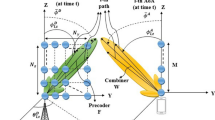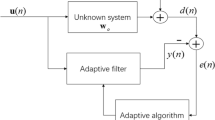Abstract
It is known that the conventional adaptive filtering algorithms can have good performance for non-sparse systems identification, but unsatisfactory performance for sparse systems identification. The normalized least mean absolute third (NLMAT) algorithm which is based on the high-order error power criterion has a strong anti-jamming capability against the impulsive noise, but reduced estimation performance in case of sparse systems. In this paper, several sparse NLMAT algorithms are proposed by inducing sparse-penalty functions into the standard NLMAT algorithm in order to exploit the system sparsity. Simulation results are given to validate that the proposed sparse algorithms can achieve a substantial performance improvement for a sparse system and robustness to impulsive noise environments.
























Similar content being viewed by others
References
F. Adachi, E. Kudoh, New direction of broadband wireless technology. Wirel. Commun. Mob. Comput. 7(8), 969–983 (2007). https://doi.org/10.1002/wcm.507
M.S. Aslam, N.I. Chaudhary, M.A.Z. Raja, A sliding-window approximation-based fractional adaptive strategy for Hammerstein nonlinear ARMAX systems. Nonlinear Dyn. 87(1), 519–533 (2017). https://doi.org/10.1007/s11071-016-3058-9
R. Baraniuk, Compressive sensing. IEEE Signal Process. Mag. 24(4), 118–121 (2007). https://doi.org/10.1109/msp.2007.4286571
J. Benesty, T. Gänsler, D.R. Morgan, M.M. Sondhi, S.L. Gay, Advances in Network and Acoustic Echo Cancellation (Springer, Berlin, 2001). https://doi.org/10.1007/978-3-662-04437-7
J. Benesty, S.L. Gay, An improved PNLMS algorithm, in IEEE International Conference on Acoustics, Speech, and Signal Processing (ICASSP), Orlando, FL, USA, May 2002, pp. 1881–1884. https://doi.org/10.1109/icassp.2002.5744994
E. Cand‘es, Compressive sampling. Int. Congr. Math. 3, 1433–1452 (2006). https://doi.org/10.4171/022-3/69
J. Chambers, A. Avlonitis, A robust mixed-norm adaptive filter algorithm. IEEE Signal Proc. Lett. 4(2), 46–48 (1997). https://doi.org/10.1109/97.554469
N.I. Chaudhary, M. Ahmed et al., Design of normalized fractional adaptive algorithms for parameter estimation of control autoregressive systems. Appl. Math. Model. 55, 698–715 (2018). https://doi.org/10.1016/j.apm.2017.11.023
N.I. Chaudhary, S. Zubair, M.A.Z. Raja, A new computing approach for power signal modeling using fractional adaptive algorithms. ISA Trans. 68, 189–202 (2017). https://doi.org/10.1016/j.isatra.2017.03.011
Y. Chen, Y. Gu, A.O. HERO III, Sparse LMS for system identification, in IEEE International Conference on Acoustics, Speech, and Signal Processing (ICASSP), Taipei, Taiwan, April 2009, pp. 3125–3128. https://doi.org/10.1109/icassp.2009.4960286
Z. Chen, S. Haykin, S.L. Gay, Proportionate Adaptation: New Paradigms in Adaptive Filters, Ch. 8 (Wiley, New York, 2005)
S. Cho, D.K. Sang, Adaptive filters based on the high order error statistics, in IEEE Asia Pacific Conference on Circuits and Systems, Seoul, South Korea, November 1996, pp. 109–112. https://doi.org/10.1109/apcas.1996.569231
S.H. Cho, S.D. Kim, H.P. Moon, J.Y. Na, Least mean absolute third (LMAT) adaptive algorithm: Mean and mean-squared convergence properties, in Proceedings of Sixth Western Pacific Regional Acoustics Conference, Hong Kong, China, November 1997, pp. 305-310
H. Deng, M. Doroslovacki, Improving convergence of the PNLMS algorithm for sparse impulse response identification. IEEE Signal Process. Lett. 12(3), 181–184 (2005). https://doi.org/10.1109/lsp.2004.842262
P.S.R. Diniz, Adaptive Filtering: Algorithms and Practical Implementations, 3rd edn. (Springer: Boston, MA, USA, 2008). ISBN: 978-0-387-31274-3
D.L. Donoho, Compressed sensing. IEEE Trans. Inf. Theory 52(4), 1289–1306 (2006). https://doi.org/10.1109/tit.2006.871582
D.L. Duttweiler, Proportionate normalized least-mean-squares adaptation in echo cancellers. IEEE Trans. Speech Audio Process. 8(5), 508–518 (2000). https://doi.org/10.1109/89.861368
G. Gui, L. Dai, B. Zheng, L. Xu, F. Adachi, Correntropy induced metric penalized sparse RLS algorithm to improve adaptive system identification, in IEEE 83rd Vehicular Technology Conference (VTC Spring), Nanjing, China, May 2016. https://doi.org/10.1109/vtcspring.2016.7504179
S. Haykin, Adaptive Filter Theory, 4th edn. (Prentice-Hall: Upper Saddle River, NJ, USA, 2002). ISBN: 978-0-130-90126-2
J. J. Jeong, S. W. Kim, Exponential normalized sign algorithm for system identification, in International Conference on Information Communications and Signal Processing International Conference (ICICS), Singapore, December 2011, pp. 1–4. https://doi.org/10.1109/icics.2011.6174219
Z. Jin, Y. Li, Y. Wang, An enhanced set-membership PNLMS algorithm with a correntropy induced metric constraint for acoustic channel estimation. Entropy 19(6), 1–14 (2017). https://doi.org/10.3390/e19060281
A.W.H. Khong, P.A. Naylor, Efficient use of sparse adaptive filters, in Proceedings of the 40th Asilomar Conference on Signals, Systems and Computers (ACSSC ‘06), Pacific Grove, CA, USA, 29 Oct.-1 Nov. 2006, pp. 1375–1379. https://doi.org/10.1109/acssc.2006.354982
Y.H. Lee, J.D. Mok, S.D. Kim, S.H. Cho, Performance of least mean absolute third (LMAT) adaptive algorithm in various noise environments. Electron. Lett. 34(3), 241–243 (1998). https://doi.org/10.1049/el:19980181
Y. Li, Z. Jin, Y. Wang, R. Yang, A robust sparse adaptive filtering algorithm with a correntropy induced metric constraint for broadband multi-path channel estimation. Entropy 18(10), 1–14 (2016). https://doi.org/10.3390/e18100380
J. Lin, M. Nassar, B.L. Evans, Impulsive noise mitigation in powerline communications using sparse Bayesian learning. IEEE J. Sel. Areas in Commun. 31(7), 1172–1183 (2013). https://doi.org/10.1109/jsac.2013.130702
D.P. Mandic, E.V. Papoulis, C.G. Boukis, A normalized mixed-norm adaptive filtering algorithm robust under impulsive noise interference, in Proceedings of IEEE International Conference on Acoustics, Speech, and Signal Processing (ICASSP’03), Hong Kong, China, April 2003, pp. 333–336. https://doi.org/10.1109/icassp.2003.1201686
E.V. Papoulis, T. Stathaki, A normalized robust mixed-norm adaptive algorithm for system identification. IEEE Signal Proc. Lett. 11(1), 56–59 (2004). https://doi.org/10.1109/lsp.2003.819353
S. Pei, C. Tseng, Least mean p-power error criterion for adaptive FIR filters. IEEE J. Sel. Areas Commun. 12(9), 1540–1547 (1994). https://doi.org/10.1109/49.339922
M.A.Z. Raja, N.I. Chaudhary, Two-stage fractional least mean square identification algorithm for parameter estimation of CARMA systems. Sig. Process. 107, 327–339 (2015). https://doi.org/10.1016/j.sigpro.2014.06.015
A.H. Sayed, Fundamentals of Adaptive Filtering (Wiley- NJ, USA, 2003). ISBN: 0-471-46126-1
W.F. Schreiber, Advanced television systems for terrestrial broadcasting: Some problems and some proposed solutions. Proc. IEEE 83(6), 958–981 (1995). https://doi.org/10.1109/5.387095
S. Seth, J.C. Principe, Compressed signal reconstruction using the correntropy induced metric, in Proceedings of IEEE International Conference on Acoustics, Speech, and Signal Processing (ICASSP), Las Vegas, USA, 31 March–4 April 2008, pp. 3845–3848. https://doi.org/10.1109/icassp.2008.4518492
M. Shao, C.L. Nikias, Signal processing with fractional lower order moments: Stable processes and their applications. Proc. IEEE 81(7), 986–1010 (1993). https://doi.org/10.1109/5.231338
D.T.M. Slock, On the convergence behavior of the LMS and NLMS algorithms. IEEE Trans. Signal Process. 41(9), 2811–2825 (1993). https://doi.org/10.1109/78.236504
M.M. Sondhi, The history of echo cancellation. IEEE Signal Process. Mag. 23(5), 95–102 (2006). https://doi.org/10.1109/msp.2006.1708416
O. Taheri, S.A. Vorobyov, Sparse channel estimation with Lp-norm and reweighted L1-norm penalized least mean squares, in Proceedings of the IEEE International Conference on Acoustics, Speech and Signal Processing (ICASSP), Prague, Czech Republic, May 2011, pp. 2864–2867. https://doi.org/10.1109/icassp.2011.5947082
O. Taheri, S.A. Vorobyov, Reweighted l1-norm penalized LMS for sparse channel estimation and its analysis. Signal Process. 104(2014), 70–79 (2014). https://doi.org/10.1016/j.sigpro.2014.03.048
R. Tibshirani, Regression shrinkage and selection via the lasso. J. R. Stat. Soc. B 58(1), 267–288 (1996)
E. Walach, B. Widrow, The least mean fourth (LMF) adaptive algorithm and its family. IEEE Trans. Inf. Theory 30(2), 275–283 (1984). https://doi.org/10.1109/tit.1984.1056886
Y. Wang, Y. Li, F. Albu, R. Yang, Sparse channel estimation using correntropy induced metric criterion based SM-NLMS algorithm, in Proceedings of the IEEE Wireless Communications and Networking Conference (WCNC), San Francisco, USA, March 2017, pp. 1–6. https://doi.org/10.1109/wcnc.2017.7925628
B. Widrow, S.D. Stearns, Adaptive Signal Processing (Prentice Hall: NJ, USA, 1985). ISBN: 0-13-004029-0
F.Y. Wu, F. Tong, Non-uniform norm constraint LMS algorithm for sparse system identification. IEEE Commun. Lett. 17(2), 385–388 (2013). https://doi.org/10.1109/lcomm.2013.011113.121586
H. Zhao, Y. Yu, S. Gao, Z. He, A new normalized LMAT algorithm and its performance analysis. Signal Process. 105(12), 399–409 (2014). https://doi.org/10.1016/j.sigpro.2014.05.018
Acknowledgements
The work of Felix Albu was supported by a grant from the Romanian National Authority for Scientific research and Innovation, CNCS/CCCDI-UEFISCDI project number PN-III-P4-ID-PCE-2016-0339.
Author information
Authors and Affiliations
Corresponding author
Additional information
Publisher's Note
Springer Nature remains neutral with regard to jurisdictional claims in published maps and institutional affiliations.
Rights and permissions
About this article
Cite this article
Pogula, R., Kumar, T.K. & Albu, F. Robust Sparse Normalized LMAT Algorithms for Adaptive System Identification Under Impulsive Noise Environments. Circuits Syst Signal Process 38, 5103–5134 (2019). https://doi.org/10.1007/s00034-019-01111-3
Received:
Revised:
Accepted:
Published:
Issue Date:
DOI: https://doi.org/10.1007/s00034-019-01111-3




